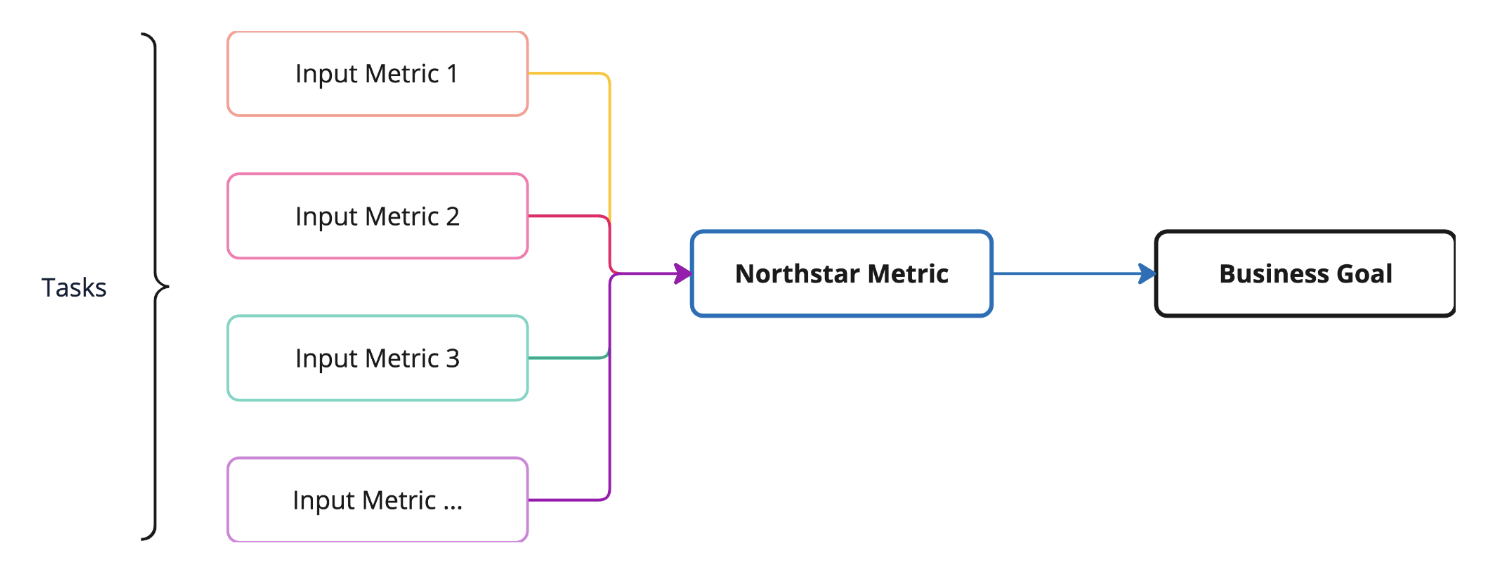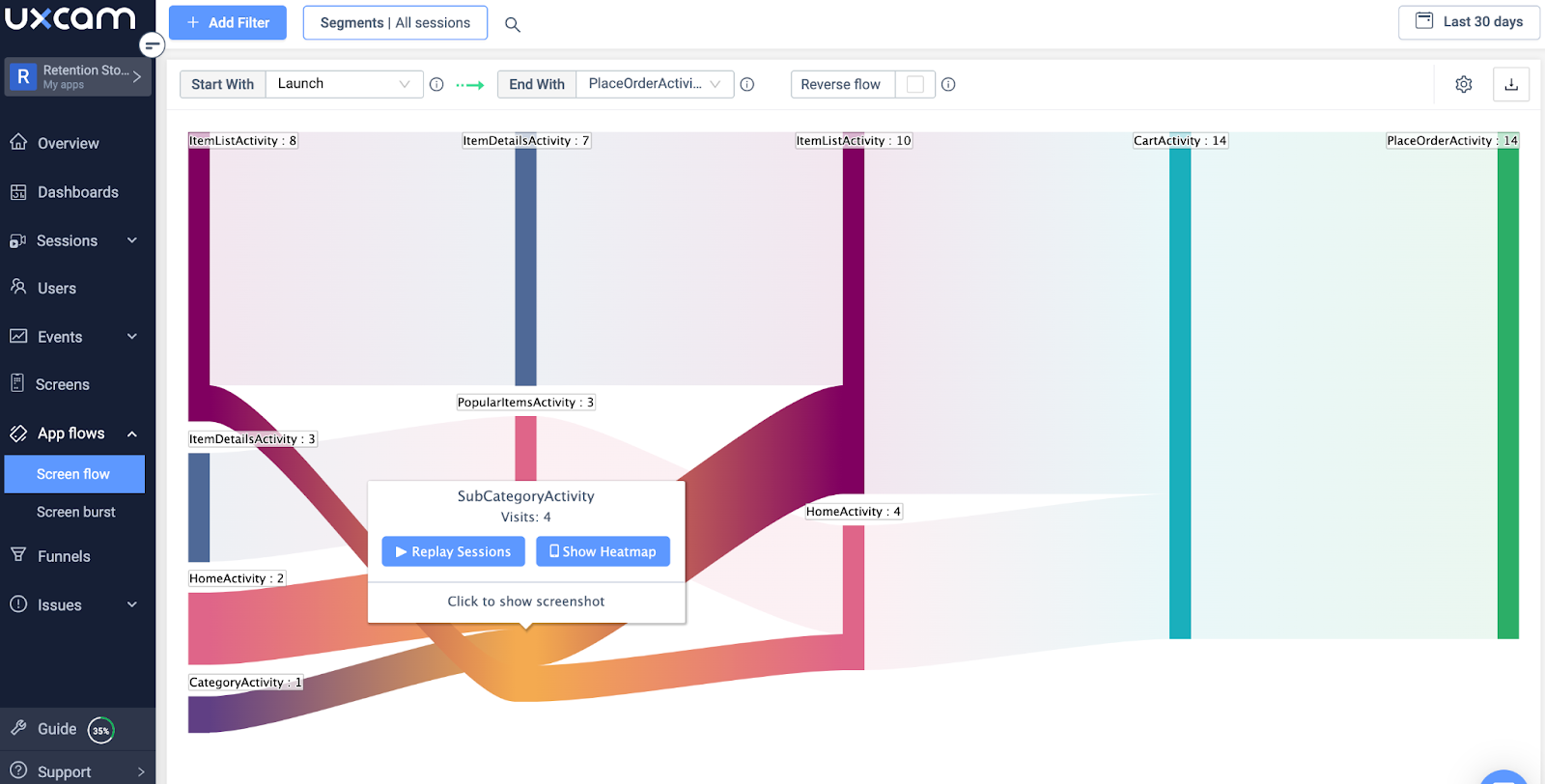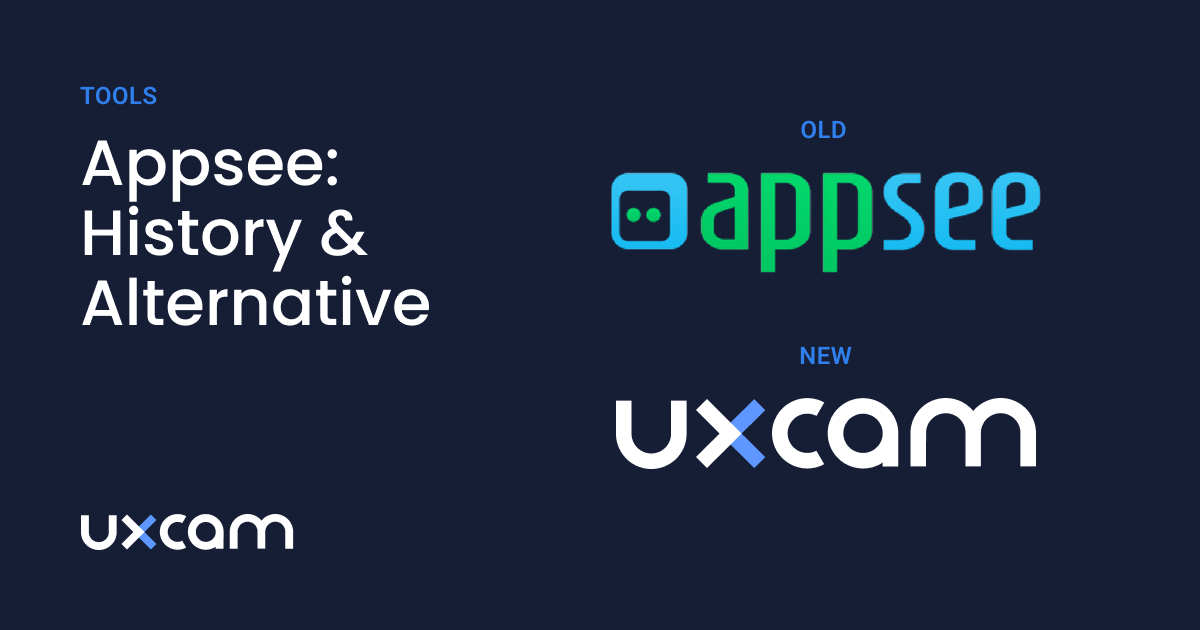North Star Metric Framework - A Comprehensive Guide
PUBLISHED
5 November, 2023

Growth Manager
North Star Metrics give businesses a point of reference for measuring success. It’s an effective way to keep track of a company’s progress and overall performance while coordinating the efforts of multiple teams.
But it can be difficult to know which metrics you should track and how they will affect your business.
North Star Metric (NSM) framework provide a blueprint for choosing the right NSMs and input metrics, setting goals, and tracking progress over time. In this UXCam guide, we’ll show you how to create your own NSM framework that will help you monitor and improve the performance of your business.
Let’s get started.
What is the North Star Metric framework?
A North Star Metric (NSM) framework is a complete map of your NSM.

The framework includes the factors that influence or change it (i.e., work and input metrics) and the factors it changes (i.e., business outcomes). The goal of creating an NSM framework is to give you a comprehensive understanding of how your business works and how different elements interact with each other.
Elements of the North Star Metric framework
Your North Star Metric
Obviously, your North Star Metric is the central element of your NSM framework. It's the measure of success that you want to achieve as a business, and will serve as your guiding light in all decisions and actions.
To choose a good North Star Metric, use the following criteria:
Expresses value: An NSM helps teams understand precisely how customers get value from their product. So, metrics based on behavior or actions users take are good expressions of value, rather than metrics like registered users or daily active users.
Success indicator: For example, your annual income from subscribers for your subscription-based app is not a suitable North Star Metric. Instead, the business could focus on identifying the characteristics of a user likely to renew their subscription.
Actionable: A good NSM shouldn’t be an on-the-surface vanity-type metric. It should be tied into an outcome directly influenced by the app. For example, suppose a business wanted to improve the experience of an HR app. In a scenario like that, their NSM shouldn’t count how long an employee stays with their company, as the app will not directly impact employee retention.
Measurable: It can be quantitatively tracked. For example, a team creating thought-provoking content wants to know how many people quietly reflect while watching the content. This is challenging to measure, even the viewers were asked. A better way to track whether the content encourages reflection is to count the number of conversations shared on message platforms regarding the content.
And speaking of learning customer characteristics, UXCam provides accurate behavior analytics to support NSM monitoring.
We collect data that helps you form an empathic understanding of your customer’s behavior—but more on our role in this process later.
Input metrics
Input metrics are metrics that feed into your NSM.
For example, Facebook’s NSM is “monthly active users”—metrics that might influence that NSM include daily logins, monthly page views, and ad engagement.
Knowing these input metrics can help you determine which areas of your business to focus on to move the needle toward your NSM. This data provides granular detail into where you are performing well and where there might be areas for improvement.
How to identify input metrics
Consider this template when pinpointing your input metrics:
I believe < NORTH STAR METRIC > is a function of < X, Y, and Z >. I also believe that there is some independence between X, Y, and Z (e.g., changes in one function aren’t immediately affected in the others).
You’ll start with a hypothesis and validate (or invalidate) it through testing and data analysis.
Process and work
“Work” encompasses all activities associated with the NSM and input metrics.
It could involve research, software development, app prototyping, testing, design, and other related tasks. Teams should tie their development techniques to their North Star, and work should be directed by it.
Benefits of using the North Star Metric framework
In addition to the advantages previously mentioned, implementing the NSM Framework results in:
Improved decision-making with clear and quantifiable details.
Goal alignment between teams and stakeholders.
A high-level understanding of product vision and strategy.
More customer focus and adding value through product-led offerings.
Enhanced systems and procedures for successful products.
How to implement the North Star Metric framework
Step 1 - Define your NSM
Begin by identifying the one metric that counts.
It should tie directly into your overall business objectives, so define your business goals. The most important task when choosing the right NSM is to decide the type of “game” you’re playing—the game is your core customer engagement model.
According to research, there are three possible areas (games) a digital product can fall into:
The Attention Game: Products that offer value when they hold a customer’s attention (think: Spotify, Netflix, etc.).
The Transaction Game: Products that offer value when customers transact (think: Amazon, Uber, etc.).
The Productivity Game: Products that offer value when customers successfully complete an action (think: Slack, Wrike, etc.).
Once you know what “game” you are playing, you should be able to determine the high-level objectives for your NSM—but you still have some flexibility.
For example, an obvious attention-focused North Star Metric for Netflix is “total time watched”, but that may not be the most interesting or impactful metric to optimize for. Alternatives like “average time watched per user” or “percentage of users watching at least 1 show each week” can give you even more valuable insight.
Step 2 - Understand your customer journey
To create an accurate North Star Metric framework, you need to understand the customer journey.
Start by mapping out each of the important touchpoints and metric opportunities throughout your customers’ experience—including initial acquisition, onboarding, usage, and retention. This will help ensure that you are factoring in all possible interactions with customers and optimizing for a broad range of objectives.

UXCam’s journey analysis, session replays, and heatmaps functionality will show you precisely how your customers behave when interacting with your app, help you identify touchpoints, and whether they take the desired actions that lead to achieving their goals.
Step 3 - Segment your user base
Customize your NSM to specific user needs by grouping your customers by demographics, behavior, usage patterns, etc.
UXCam’s segmentation analysis helps you understand your customers on a deeper level. Uncover trends and patterns revealing engagement, conversion, and churn drivers. Our pre-built new, loyal, returning, and slipping away user segments will show you more about how the characteristics of a user correlate with user behavior.
Step 4 - Data collection and analysis
Your North Star Metric framework is only valuable if you’re collecting and analyzing the right data.
Within your analytics tool, set up tracking for your NSM and input metrics to set up dashboards. This will allow you to quickly pinpoint the insights that are most important to your customers’ journey and use them to refine your approach.
UXCam offers a lightweight and Google-approved SDK to collect quantitative and qualitative data without disturbing your users. We start collecting from the very start until the end of every user’s session, so you’ll get all the information regarding interaction and behaviors throughout their journeys.
Plus, you can keep everyone in the loop with customizable dashboards. Make it easy for teams company-wide to track, monitor, and report on your North Star Metric and inputs metrics at any time
Set a baseline and targets
Establish a fixed reference point to understand your current performance and make it easy to see progress. Define success using specific and measurable targets for a clear road to improvement.
Keep moving towards achieving your targets by continuously experimenting with new strategies and features to impact your NSM positively. Consider A/B testing to learn your most effective UI designs, session replays, and heat mapping to determine the results of new feature uptake and UX improvements.
Use UXCam for North Star Metric success
A good NSM framework sets priorities, gets teams to communicate more, and assists in the move toward a product-driven strategy. When choosing your NSM, remember that it needs to reflect customer value, be easily measurable, and increase profits.
At UXCam, we offer mobile product teams the right tools to help them measure and improve their NSM. With our session replays, heatmaps, and user journey mapping capabilities, teams can quickly identify issues that they can act on to increase customer satisfaction and engagement.
Get started with a free trial today. You might also be interested in these;
North Star metric examples from tech giants
How to define your North Star metric User adoption dashboard examples and how to use them Product usage segmentation - Best techniques and tools
Customer needs analysis examples - Two real case studies
UX concept testing - Benefits, best practices & pools
UX audit - A beginner's guide (steps, templates & checklist)
AUTHOR

Tope Longe
Growth Manager
Ardent technophile exploring the world of mobile app product management at UXCam.
Get the latest from UXCam
Stay up-to-date with UXCam's latest features, insights, and industry news for an exceptional user experience.
Related articles
Product best practices
How to make and justify design decisions with data
Are you struggling to justify your design decisions to different stakeholders? Using data to support your decisions can make your life much...

Akorede J. Ayanbisi
Product best practices
Top 11 Remote Usability Testing Tools You Can Use Now
Usability testing tools that will put your mind at...

Jonas Kurzweg
Growth Lead
Product best practices
Appsee Analytics - History, Acquisition & Best Alternative
If you are looking for an alternative to Appsee or a powerful mobile analytics tool, you should start a free trial with...

Jonas Kurzweg
Growth Lead


